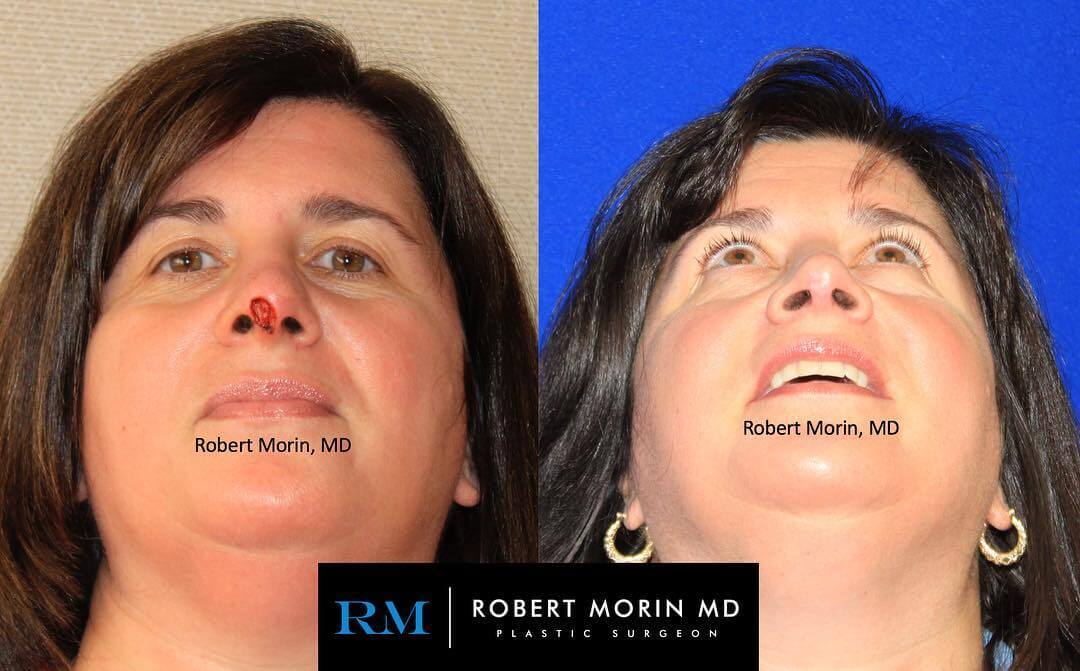
If you have been diagnosed with skin cancer, you may be advised to undergo Mohs surgery.
Pioneered by Dr. Frederick Mohs in the 1930s, Mohs surgery is a detailed micrographic surgical technique used to precisely remove skin cancers. Mohs surgery excises cancerous skin cells layer by layer, allowing the greatest amount of surrounding healthy tissue to be preserved during the process.


Mohs surgery is considered the most effective treatment of the two most common skin cancers (basal cell carcinomas and squamous cell carcinomas.) Basic characteristics of the different types of skin cancer include:
Mohs surgery is often chosen for treating a recurring case of a skin cancer that is large, aggressive, or has a border irregularity.
Mohs surgery is an outpatient procedure, requiring local anesthesia. Once local anesthesia has been administered, the Mohs dermatologist will progressively remove layers of skin with a scalpel–beginning with the visible cancer and a thin underlying layer– and examine each layer under the microscope for signs of cancer. The successive removal of skin will continue until the skin samples are determined to be cancer-free.
The duration of the procedure is determined largely by the time it takes for the tissue analysis, rather than the excision process itself, which is done relatively quickly.
Estimating the procedure time can be difficult, as it is impossible to know the exact extent of the cancer beforehand.
Because the analysis of skin cells occurs during the procedure, the Mohs dermatologist can accurately verify the presence of cancer cells and assess the skin cancer’s depth. The cure rate for Mohs surgery is 98 percent or higher, far exceeding the success rate for local excision (the removal of all the tissue at once). An additional benefit of Mohs surgery is a cosmetic one: the refined approach saves healthy tissue and minimizes potential scarring.
Ready to start looking your best? We offer virtual and in-office consultations.
If your Mohs procedure was extensive, the Mohs dermatologist may decide to refer you to Dr. Morin for reconstruction.
How quickly the reconstruction heals will vary from individual to individual. On average, the healing time takes 4-6 weeks. The treated area may be red for a few months following surgery, but patients can expect the surgical scar to improve over time; in some instances, it can take up to 18 months for the area to completely heal. Dr. Morin recommends following some basic guidelines to facilitate healing:
Mohs surgery reconstruction is a safe procedure with few risks of serious side effects. However, like every surgery, Mohs surgery reconstruction carries a risk of complications, including bleeding, infection, numbness, and keloid scarring. Following a Mohs surgery reconstruction procedure, it is important to monitor the wound as it heals and report any anomalies or unusual changes to Dr. Morin.
If you have been treated for skin cancer, it is important to plan for regular follow-up visits to your dermatologist to monitor the skin and check for new or recurring cancers.
A skin cancer diagnosis can be alarming and anxiety-producing. The good news is that if the cancer has been detected early enough, it can be treated with a high level of success. If you need to have your skin cancer removed, contact Dr. Morin for a consultation. He regularly performs Mohs surgery reconstruction and has helped patients recover healthy, cancer-free skin.
Ready to start looking your best? We offer virtual and in-office consultations.